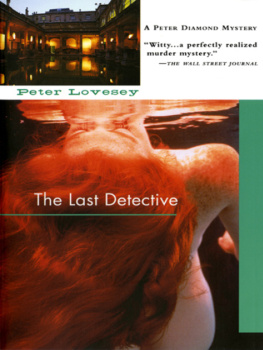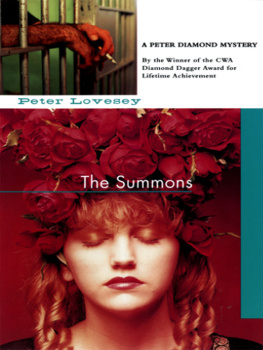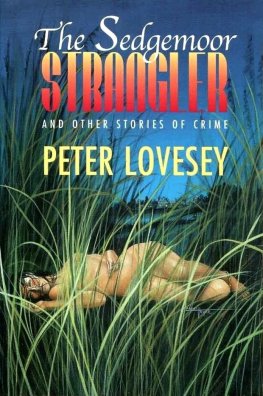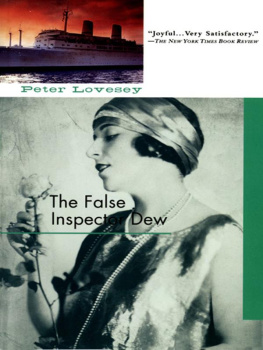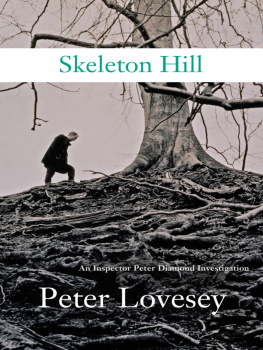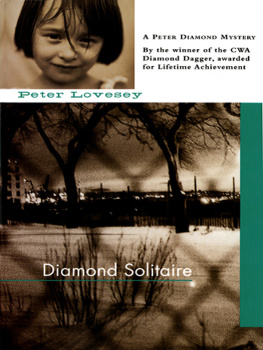Peter Lovesey - Waxwork
Here you can read online Peter Lovesey - Waxwork full text of the book (entire story) in english for free. Download pdf and epub, get meaning, cover and reviews about this ebook. genre: Detective and thriller. Description of the work, (preface) as well as reviews are available. Best literature library LitArk.com created for fans of good reading and offers a wide selection of genres:
Romance novel
Science fiction
Adventure
Detective
Science
History
Home and family
Prose
Art
Politics
Computer
Non-fiction
Religion
Business
Children
Humor
Choose a favorite category and find really read worthwhile books. Enjoy immersion in the world of imagination, feel the emotions of the characters or learn something new for yourself, make an fascinating discovery.

- Book:Waxwork
- Author:
- Genre:
- Rating:3 / 5
- Favourites:Add to favourites
- Your mark:
- 60
- 1
- 2
- 3
- 4
- 5
Waxwork: summary, description and annotation
We offer to read an annotation, description, summary or preface (depends on what the author of the book "Waxwork" wrote himself). If you haven't found the necessary information about the book — write in the comments, we will try to find it.
Waxwork — read online for free the complete book (whole text) full work
Below is the text of the book, divided by pages. System saving the place of the last page read, allows you to conveniently read the book "Waxwork" online for free, without having to search again every time where you left off. Put a bookmark, and you can go to the page where you finished reading at any time.
Font size:
Interval:
Bookmark:
Peter Lovesey
Waxwork
SUNDAY, 15th APRIL
There was nothing shifty about James Berrys eyes. No sideward glance or drooping lids. They were wide and steady. The Telegraph had called them codfish eyes once. After that he had changed to the Graphic.
The eyes were scanning it now, line by line, column by column. The reports on criminal matters, headed Police Intelligence, interested him most. Over the mantelpiece in the front room of his house in Bilton Place, Bradford, were two gilt frames, each filled with eight small photographs of men and women, mounted on best Bristol board. Each was a convicted murderer.
They were a select bunch. They all came in the carte-de-visite size, which showed they were not riffraff. Two were doctors.
This Sunday evening in 1888 his wife was talking about them. I believe I could stand that lot hanging over my front room mantelpiece if there was summat else up there beside them.
He looked over his paper. What did you have in mind?
A picture of you, love.
It had never occurred to him to put himself up there.
Now that he considered it, he would not look bad in sepia. At thirty-six, he still had most of his hair. His face was manly, right enough, broad and powerful, with a good growth of black beard. There was a deep scar down the right cheek, but the beard covered most of it. He had a notion that his wife liked the scar. She had never inquired how he came by it, but there were times when she traced it with her fingertips. Ever so lightly.
He told her she was talking rubbish and went back to the Graphic. There was a case of poisoning in Kew.
She said the rogues gallery made her flesh creep. She wanted to look up from her sewing once in a while and see an honest, God-fearing face.
He knew why she mentioned the Almighty. They both took a pride in the lay-preaching. Folk sat up in chapel when James Berry went to the pulpit. He could speak with authority on the wages of sin.
Theres that elegant studio in Bridge Street, she went on. You know-with velvet at the window? Ive seen what he can do. Beautiful likenesses. You can wear your chapel suit and butterfly collar. Youll make a grand picture, Jim!
He told her straight that he did not hold with photography. She said it was no sin as far as she was aware. There was nothing about it in the Good Book that she could recollect.
He did not hold with sarcasm either. If it had not been the Sabbath he would have cuffed her for that. He told her so. She went out to make the cocoa.
The Graphic had a lot to say about the Kew murder. It seemed they had arrested a young married woman. Her people were well-to-do. They would see she was well represented at the trial. Someone of the calibre of Clarke or Russell was expected to lead the defence. A classic trial was in prospect.
When she appeared with his mug and a biscuit he told her why he had no intention of going to the studio in Bridge Street. In my sort of work you dont go out of your way to be recognised. You get enough of that, without photographs. If I had my picture took in Bradford, inside the hour it would be in t shop window with James Berry, Public Hangman in large letters under it.
She was unimpressed. Weve no cause to be ashamed, Jim. If folk round here want to see your likeness, why not let them?
He told her Bradford folk did not matter. They knew him mostly, any road. The trouble would start when some newspaper reporter came by. He would be into that shop like a ferret. Next thing, the picture would be plastered over every paper in the kingdom. It might easily cost them the job.
That silenced her.
No more was said on the matter that evening. Yet Berry did not dismiss it from his mind.
WEDNESDAY, 6th JUNE
The trial of Miriam Cromer took place at the height of the London season of 1888. It was fixed for the week before Ascot, at the Central Criminal Court.
The preliminary hearings at the inquest and police court had set out the facts like visiting cards. The deceased, Josiah Perceval, had been employed as assistant to Mr Howard Cromer, the owner of a photographic studio in Kew. It was a fashionable place, patronised by society. The name of Cromer was familiar to readers of The Tatler. On the afternoon of Monday, 12th March, a Dr Matthew Eagle had visited the studio, not to have his photograph taken, but to confirm that Josiah Perceval was a dead man.
The cause of death was poisoning. The post mortem on 14th March confirmed the presence of potassium cyanide, one of the fastest-acting poisons known to science. The dregs of a glass of madeira beside Percevals corpse had been analysed and found to contain the poison. A bottle of Scheeles solution of potassium cyanide was kept in the processing room at the studio for use as a fixing agent. It was found in the poison cabinet half empty.
The first theory of the police was suicide. Perceval had been found alone. No one else had been in the studio rooms for two hours. He was understood to have had financial worries. He owed his bookmaker sixty-seven pounds.
The suicide theory was discarded when a decanter of madeira found in a chiffonier in the studio was analysed and found to contain cyanide. A man proposing to poison himself would put the poison in the glass he drank from, not the decanter. The person in the house responsible for keeping the decanters topped up was the proprietors wife, Mrs Miriam Cromer. She had attended to it at noon on the day of Percevals death. Before two oclock she had gone out to her dressmakers for a fitting. Her husband was in Brighton for a meeting of the Portrait Photographers League, so Perceval was alone in the studio. It was an open secret that he helped himself to madeira when he had the opportunity.
At twenty minutes past three the housekeeper and a maidservant who were in the basement underneath the studio heard a heavy thump as if someone had fallen. It was followed by other sounds, a series of knocks as if someone were beating upon the floor. There was an order that no servant was to be seen in the studio in business hours, but the sounds were so unusual and alarming that they took it upon themselves to investigate. They found Perceval lying rigid on the carpet, fighting for breath, his eyes glassy and staring, his skin turning blue. He was conscious but incapable of speech.
The maid ran to fetch Dr Eagle, but in the ten minutes it took for him to be summoned, Perceval died.
Mrs Miriam Cromer returned to the house shortly before four oclock. She came directly to the studio. Asked whether she knew if there was any form of poison in the house, she took Dr Eagle to the cabinet and showed him where the cyanide was kept. A few minutes later she fainted.
During the next week painstaking work by the police discovered a remarkable collation between the financial affairs of Josiah Perceval and certain transactions made by Miriam Cromer. In October and December, 1887, and January and February, 1888, Perceval had settled debts with his bookmaker of?10,?12,?14 and?15 respectively. At dates that closely corresponded, Mrs Cromer had visited a Brentford pawnbroker and obtained precisely similar sums. On the advice of her solicitor, Mr Simon Allingham, she declined to appear as a witness at the inquest on 28th March. The coroners jury returned a verdict of wilful murder against her. That same afternoon she was formally charged and taken into custody.
At the magisterial hearing on 9th and 10th April, Allingham appeared for Miriam Cromer. When the charge was put he instructed her not to speak, and then reserved her defence. She was committed for trial at the Old Bailey.
In the next two months, public interest reached such a pitch of intensity that the sheriffs decided to issue special admission tickets to the public gallery of Number One Court. At Etons Fourth of June celebration these were changing hands for ten guineas. By Derby Day on the sixth, the price had risen to fifteen. It was rare to see a beautiful woman brought to justice accused of causing a mans agonising death; positively not to be missed when there were possibilities of salacious overtones. Such cases passed into legend. No sixpenny novel ever published rivalled the candour of the disclosures in court of Miss Madeleine Smiths indiscretions with her French lover, Florence Bravos adultery with an ageing doctor, or Adelaide Bartletts intimacy with a minister of the Wesleyan Church. In the case of Miriam Cromer no-one needed telling that the payments to Josiah Perceval suggested blackmail. The nation caught its breath and prepared for revelations.
Font size:
Interval:
Bookmark:
Similar books «Waxwork»
Look at similar books to Waxwork. We have selected literature similar in name and meaning in the hope of providing readers with more options to find new, interesting, not yet read works.
Discussion, reviews of the book Waxwork and just readers' own opinions. Leave your comments, write what you think about the work, its meaning or the main characters. Specify what exactly you liked and what you didn't like, and why you think so.

